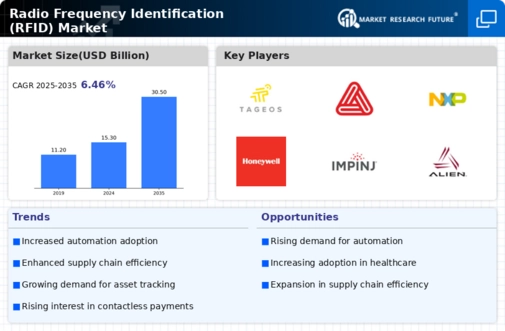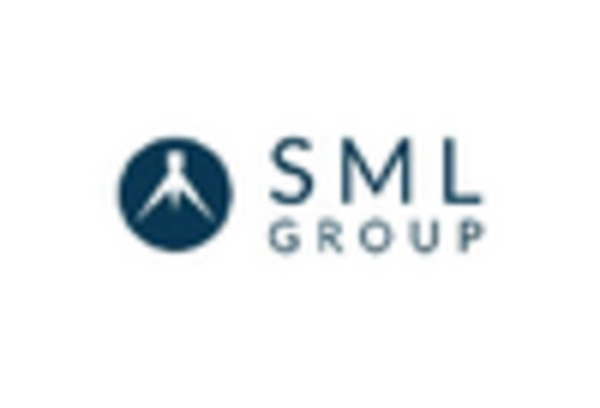North America : Market Leader in RFID Technology
North America continues to lead the Radio Frequency Identification (RFID) market, holding a significant share of 12.0 in 2024. The growth is driven by increasing adoption across various sectors, including retail, healthcare, and logistics. Regulatory support and technological advancements further fuel demand, as businesses seek efficient inventory management and tracking solutions. The region's focus on innovation and integration of IoT technologies enhances the market's potential.
The competitive landscape in North America is robust, featuring key players such as Zebra Technologies, Impinj, and Avery Dennison. These companies are at the forefront of developing advanced RFID solutions, catering to diverse industries. The presence of established firms and a strong emphasis on research and development contribute to the region's market dominance. As businesses increasingly recognize the value of RFID technology, North America is poised for continued growth in this sector.
Europe : Emerging RFID Adoption Trends
Europe's RFID market is projected to reach 6.0 by 2025, driven by increasing demand for automation and efficiency in various industries. The region is witnessing a surge in RFID adoption, particularly in retail, logistics, and healthcare. Regulatory initiatives aimed at enhancing supply chain transparency and security are also contributing to market growth. The European Union's focus on digital transformation and sustainability further supports the expansion of RFID technologies.
Leading countries in Europe, such as Germany, France, and the UK, are at the forefront of this growth. The competitive landscape includes major players like NXP Semiconductors and Avery Dennison, who are innovating to meet the evolving needs of businesses. The presence of a strong manufacturing base and a commitment to technological advancement positions Europe as a key player in The Radio Frequency Identification. As companies increasingly leverage RFID for operational efficiency, the region is set for significant advancements.
Asia-Pacific : Rapid Growth in RFID Solutions
The Asia-Pacific RFID market is expected to reach 5.0 by 2025, driven by rapid industrialization and increasing demand for automation. Countries like China, Japan, and India are leading the charge, with significant investments in technology and infrastructure. The region's growing e-commerce sector and the need for efficient inventory management are key factors propelling market growth. Additionally, supportive government policies and initiatives are fostering a conducive environment for RFID adoption.
The competitive landscape in Asia-Pacific is diverse, with key players such as SML Group and GAO RFID making significant strides. The region is characterized by a mix of established companies and emerging startups, all vying for market share. As businesses recognize the benefits of RFID technology, the Asia-Pacific market is poised for substantial growth, driven by innovation and a focus on enhancing operational efficiency.
Middle East and Africa : Growing Interest in RFID Technology
The Middle East and Africa RFID market is projected to reach 1.79 by 2025, reflecting a growing interest in automation and tracking solutions. The region is witnessing an increase in demand for RFID technology across sectors such as retail, logistics, and healthcare. Government initiatives aimed at improving supply chain efficiency and transparency are also contributing to market growth. As businesses seek to enhance operational efficiency, RFID adoption is becoming more prevalent.
Leading countries in the region, including South Africa and the UAE, are beginning to embrace RFID technology. The competitive landscape is evolving, with both local and international players entering the market. Companies are focusing on innovative solutions tailored to regional needs, creating opportunities for growth. As awareness of RFID benefits increases, the Middle East and Africa are set to experience a gradual but steady rise in market activity.















Leave a Comment